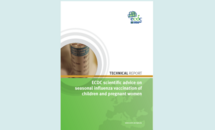Public health guidance: Seasonal influenza vaccination of children and pregnant women
The aim of this guidance document is to provide EU/EEA Member States and EU bodies with relevant information to make an informed decision on routine vaccination of healthy children and pregnant women with seasonal influenza vaccine. The options presented in this document are based on a systematic review of the literature and the opinions of a group of independent experts.
Executive Summary
Aim
The aim of this guidance document is to provide EU/EEA Member States and EU bodies with relevant information to make an informed decision on routine vaccination of healthy children and pregnant women with seasonal influenza vaccine. The options presented in this document are based on a systematic review of the literature and the opinions of a group of independent experts; the expert group also provided additional literature.
The aims of the systematic review were to collect, critically appraise and summarise:
- European data and data from other Western countries on burden of seasonal and pandemic influenza (e.g. incidence, hospitalisations, mortality, and complications) in children and pregnant women;
- European data and data from other Western countries on burden of seasonal and pandemic influenza in young children when their contacts are vaccinated;
- European data only on the safety, efficacy, effectiveness and cost effectiveness of available seasonal and pandemic influenza vaccines in children and pregnant women.
Methods
PubMed and Embase were used to collect relevant articles that were published between August 2000 and August 2010 and contained data collected in the year 2000 or later (i.e. articles that contained only data from before the year 2000 were excluded). Furthermore, an additional PubMed search for articles from three key authors (i.e. Fiore AE, Jamieson DJ, Neuzil KM) was undertaken, and some additional articles were retrieved by hand search (i.e. identified in another included paper) and other databases. Since annual vaccination of children with known risk factors for severe influenza is recommended in all EU countries, this topic was not included in the systematic literature review; nevertheless it was discussed at an expert meeting.
All possible relevant papers were critically appraised using the CoCanCPGi checklists (Annex V). Articles judged to be of insufficient quality were excluded. Examples include:
- reviews or meta-analyses in which no description of the methodology was included, or the search was not sufficiently rigorous to identify all relevant articles;
- randomised controlled trials in which the randomisation process was not described or not well executed, which could lead to bias;
- a surveillance study in which the source population was not well defined.
A meeting with experts from Europe and the USA was held in Stockholm on 15 and 16 June 2011. In preparation of the meeting, the experts read the report of the systematic review. Furthermore, the experts could provide literature, or data from other data sources in addition to the literature and data included in the systematic review. During the expert meeting, the following topics were discussed: burden of influenza in children and pregnant women, vaccine effectiveness and safety, main pros and cons with regard to vaccination of these groups in the European context, and gaps in knowledge.
Results and conclusions
What are the advantages and disadvantages of the following vaccine strategy options in the European context?
Universal immunisation of all children aged six months to 18 years without contraindications to vaccination.
Pros:
- Universal immunisation can potentially reach children who have underlying conditions, but are unaware of these and would be missed by targeted vaccination programmes.
- Vaccinating all children would lead to herd immunity thus reducing overall transmission of influenza. The extent of herd immunity produced by different immunising schedules has been estimated by mathematical modelling. However, herd immunity is difficult to investigate and there is little data available on herd immunity after influenza vaccination.
Cons:
- The burden of influenza in children five to 18 years old is considerably lower than the burden in younger children. Therefore the benefits of also vaccinating older children will be lower compared with only vaccinating children aged six months to four years, since fewer hospitalisations/deaths can be prevented.
Universal immunisation of children aged six months to four years without contraindications to vaccination.
Pros:
- The literature review found that the burden of influenza in Western countries is higher in children aged six months to four years than in children aged five to 18 years.
- Data from non-European studies suggested that influenza hospitalisations in children aged six months to four years are comparable with that in elderly or adults with underlying conditions, for whom vaccination is recommended in Europe.
- Assuming the vaccine is effective in children, it can be inferred that vaccination of all children aged six months to four years would lead to a reduction of the major influenza complications in this age group, e.g. secondary bacterial infections such as pneumonia and otitis media. This could be an important consideration especially in countries that have high levels of antibiotic resistance.
Cons:
- When countries consider introducing universal influenza vaccination of children, special attention should be paid to how this could affect the overall childhood vaccination schedule. This can vary from country to country; specific studies to assess parental attitudes towards influenza vaccination, and towards vaccination in general, can be helpful in this context.
- Hardly any European studies on vaccine effectiveness in children have been identified and there are no post-vaccine safety studies.
Targeted immunisation of all children aged six months to 18 years with known risk factors.
Pros:
- All the consulted experts agreed that children with underlying conditions should be vaccinated against seasonal influenza.
- Although the type of underlying conditions and risk factors for severe influenza infection are well defined, new categories may be included as more evidence emerges (e.g. obesity after the 2009 A(H1N1) pandemic).
Annual influenza vaccination of all pregnant women without contraindications to vaccination.
Pros:
- Vaccination could reduce the number of influenza-related hospitalisations and deaths in this group.
- Vaccination of pregnant women can potentially reduce the burden of influenza in children younger than six months old (for whom influenza vaccination and antiviral treatment are not indicated) in two ways:
- vaccination during pregnancy would reduce the risk of being infected after delivery, thus also reducing the risk of transmission to the child during the first months of life;
- an RCT conducted in Bangladesh showed proof of concept that transmission of influenza antibodies from the mother to the child takes place and protects the child. Influenza vaccination of the mother during pregnancy was shown to confer protection to the infants also in a number of observational studies. Finally, because both the use of antiviral therapy as well as influenza vaccine are not indicated for use in children younger than six months, there is lack of alternatives to protect these children against influenza, while burden is this group is known to be high.
- Vaccination could reduce the need to treat pregnant women with antivirals. Treatment with antivirals might in theory be more risky than exposure to an inactivated vaccine for which at the moment there are no indications that this causes harm.
- Assuming the vaccine is effective, it may also reduce influenza complications such as secondary bacterial infections. This could be especially important in countries that have high levels of antibiotic resistance.
- During influenza pandemics pregnant women are known to have higher hospitalisation and mortality rates than what should be expected based on population pregnancy rates; this was also observed during the 2009 A(H1N1) pandemic.
- The general view of most experts was that the advantages of vaccinating healthy pregnant women are valid and supported by evidence.
- Although there are no European data on influenza vaccine effectiveness in pregnant women, it can be inferred that vaccine effectiveness is similar to that of healthy women of childbearing age.
Cons:
- Most of the evidence supporting this scientific advice comes from non-European data. More evidence, e.g. from active surveillance systems or large cohort studies, is needed from Europe.
Download

Read more on the ECDC website
An area of controversy – immunising pregnant women against seasonal influenzaArchived
In May 2012 a WHO SAGE (Strategic Advisory Group of Experts) statement on immunisation delivered its opinion on seasonal influenza immunisation through the Weekly Epidemiological Record.(
New WHO recommendations on seasonal influenza immunization from the Strategic Advisory Group of Experts on Immunization (SAGE) - adding pregnant women as the highest priority and consideration of immunising children aged 6 months to 5 yearsArchived
WHO’s regular meeting of its Strategic Advisory Group of Experts (SAGE) on Immunization meeting (April 2012) included receiving a report from a Working Group on influenza immunisation.
Infant and children seasonal immunisation against influenza on a routine basis during inter-pandemic period
Annual influenza vaccination of risk groups has been common practice in Europe and elsewhere for many years. Routine influenza immunisation of healthy children has been recommended in some countries, to reduce morbidity among children with the potential additional benefit of reducing the spread of disease and thus indirectly protect adults at high risk of severe influenza.
More about this topic
Seasonal influenza vaccines
Guidelines, information and data on vaccination for seasonal influenza.
Immunisation information systems in the EU and EEA
This report presents the findings of a survey conducted by ECDC across EU/EEA countries that assessed the level of implementation of IIS and their functionalities, as well as the challenges encountered during the design and implementation.
Let’s talk about protection: enhancing childhood vaccination uptake
Helping parents to understand vaccination and supporting their choice to get their children protected is one of the most important aspects of the work of a primary healthcare professional.






